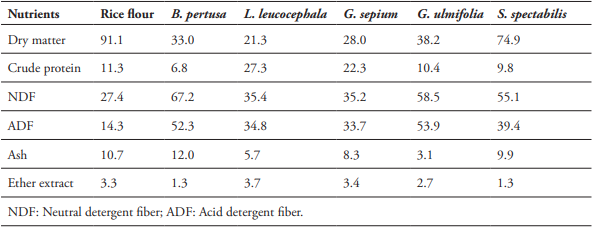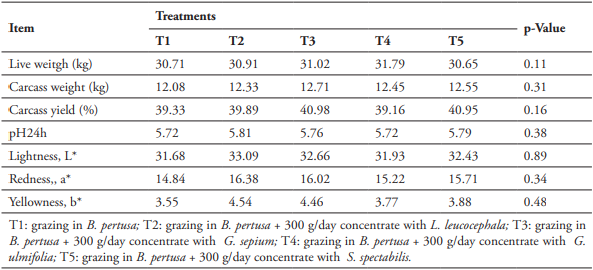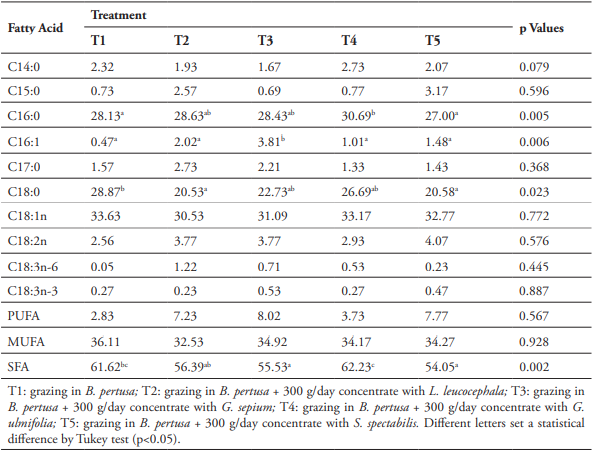Introduction
Red meat consumption has been associated with cardiovascular diseases in humans, thus, representing a serious concern for public health (Lippi et al., 2015). Obesity increase is caused by the consumption of high-carbohydrate and high-fat diets characterized by their high energy content, which leads to an excess accumulation of fat (Binnie et al., 2014). Red meats present a lipid profile with higher levels of Saturated Fatty Acids (SFA) compared with fish and chicken. Moreover, the ruminant meat levels of monounsaturated (MUFA) and polyunsaturated fatty acids (PUFA) are lowest because of the biological process of biohydrogenation made it in the rumen (Kouba & Mourot, 2011). The biohydrogenation process only allows the passage of 2% to the MUFA that are consumed (Buccioni et al., 2012). Therefore, most of the fatty acids deposited in muscle tissue are SFA. In the last few years, many researchers have looked for ways to reduce the levels of SFA in ruminants meat.
One of the most studied techniques is the supplementation with fats and oils coated with proteins, calcium soaps, and amide formations to protect MUFA and PUFA biohydrogenation and increasing their absorption in the small intestine (Cabiddu et al., 2005). However, this is an expensive technology for small-scale producers the return of investment is not readily seen. Because of that, in developing countries, there is a potential to explore the effect of tree leaves to modify the lipid profile of ruminants meat (Gadeyne et al., 2015; Sun et al., 2015). Also, this type of feeding has economic advantages because it can increase productivity and generates greater added value Besides, the PUFA concentration is higher in ruminants grass-fed than grain-fed (Cividini et al., 2014). Likewise, the maturity stages of the forage sources have a great impact on the meat fatty acid levels. In tropical farms, there is a great diversity of plants using for feeding that affect fat metabolism and its deposition in the muscles (Glasser et al., 2013).
Small ruminants farming in grazing systems is an economic activity with a high level of importance for farmers in the tropical dry forest (Adams & Ohene, 2014). However, these small productions do not have access to technology and the investment is limited, thus, affecting the productivity parameters and income (Malik et al., 2015). On the other hand, there are some unexplored benefits of these productions, such as the production of organic meats and the use of fruits and tree foliage t can improve the productivity and the quality of meat products (Caroprese et al., 2015).
Thus, this study was conducted to evaluate the effect of dietary supplementation with foliage from four tropical dry forest trees on meat quality and fatty acid composition in Colombian creole grazing lambs.
Materials and methods
Local, animal management, and chemical composition
This experiment was conducted at the experimental center “El Recreo” (326 AMSL, 32°C y 750 mm per year) of the Universidad del Tolima located at74º04’39’’W and 4º35’46’’N in the department of Tolima (Colombia). We allocated 35 Colombian creole lambs (23.4 ± 0.6 kg initial body weight, 175 ± 15 days of age). They were distributed in a completely randomized experimental design with 5 treatments and 7 experimental units by treatment. The treatments wereT1 (control): grazing in Botriochloa pertusa; T2: grazing in B. pertusa + 300 g/day concentrate with Leucaena leucocephala; T3: grazing in B. pertusa + 300 g/day concentrate with Gliricidia sepium; T4: grazing in B. pertusa + 300 g/day concentrate with Guazuma ulmifolia and T5: grazing in B. pertusa + 300 g/ day concentrate with Senna spectabilis. The concentrate for T2, T3, and T4 treatments was made with the foliage of the trees, meanwhile, for the T5 treatments we used the tree fruit, and all of them contained a premix and rice flour for all (Table 1).
Table 1 Ingredients and chemical composition of diets administered to Colombian creole lambs.

Source: Author.
The lambs were fed with the diets until obtain an average live weight of 32 (±1) kg for an experimental period of 120 d. The lambs were in grazing between the 09:00 - 17:00 with ad libitum offer of B. pertusa, water, and salt. The concentrate was supplied twice a day in each group in the feedlot (08:00 and 17:00).
Instrumental meat quality
The lambs were slaughtered at 32 (±1) kg, following the normativity of animal and welfare protection (OIE, 2013). The Longissimus dorsi (LD) was removed from both sides of the carcass and was transported under refrigeration at 4°C for further analyses at the meat quality laboratory of the University of Tolima. To evaluate meat color, a Chroma Meters CR-400 portable colorimeter was used. Results were expressed (lightness, L*; redness, a*; yellowness, b*) as the average of three measurements. After 24 h post-mortem, a Hanna Instruments HI 99163N was used for pH evaluation.
Were extracted 30 g of LD which were stored frozen at - 80°C (Wood et al., 2008) for the fatty analysis. Once the 35 samples were obtained, they were lyophilized and sent to the Toxicology Laboratory of the Universidad Nacional de Colombia for fatty acid analyzed profile according to Folch et al. (1957) and Association of Official Analytical Chemists (2007).
Statistical analysis
A completely randomized design was performed; the data was analyzed using the SAS 9.2 MIXED procedure. Shapiro Wilk test was used to evaluate normality. An ANOVA analysis of variance and a Tukey mean comparison test were performed, with a 95% level of significance. The model used in the experiment was as follows:
Where: Yijk: Dependent variable; U: Medium, Bj: Fixed effect of the Block, Ti: Fixed effect of the treatment (i = 0, 1, 2), Eijk: Residual error.
Results and discussion
Instrumental Meat quality
No significant differences were observed among groups regarding meat quality parameters (p>0.05). Color and pH values found in this study were similar to previous reports (D’Alessandro et al., 2013; Jiang et al., 2015) (Table 2). Thus, it is very important the pH decline in the first 24 hours post-mortem as it permits the conversion of muscle to meat. The pH should reach a value of approximately 5.5 in the first 24 hours because it will influence the amount of water retained by the muscle and its aging (Huff-Lonergan & Lonergan, 2005). Moreover, the pH decrease pH to 5.6 enables proteolysis and improves the meat tenderness to the meat (Hopkins et al., 2011). The meats in this study obtained an acceptable pH value (5.7±0.2), thus, edible for human consumption. On the other hand, there is a minimum-effect of the diet on meat pH values (Ekiz et al., 2009; Luciano et al., 2012).
Table 2 Effect of dietary supplementation with tropical dry forest trees foliage on carcass characteristics and meat quality in Colombian creole lambs.

Source: Author.
Meat color is an important parameter for evaluation of meat aging being both groups of myoglobin (oxi/met) determine this characteristic. In many studies, when the coordinate a is superior to 18, it is a signal that the oxidation of iron is high and the meat quality is low (Wood et al., 2004). On the other hand, when the oxygen present has not oxidized the color of meat becomes bright red and the coordinate b will be possible to found above 9, indicating bacterial colonization and meat decomposition (Ponnampalam et al., 2012). Regarding coordinate L, this one is closely related whit the coordinates a and b. Only to distinguish which one offers the greatest influence we may have to determine the type of myoglobin who predominates in the meat (Leygonie et al., 2012).
Fatty acid composition
The fatty acid profile in this study was similar to the previous reports (Scerra et al., 2011; Vasta et al., 2012; Gómez et al., 2014). The content of saturated fatty acids (SFA) in the meat was lower in T3 and T5 (Table 3). However, the MUFA and PUFA levels do not show differences among the treatments (p>0.05).
Table 3 Fatty acid composition (g/100 g of identified fatty acid) in Longissimus dorsis of Colombian creole lambs with dietary supplementation with tropical dry forest trees foliage.

Source: Author.
Changes in the fatty acid composition of meat depend principally on factors associated with the diet. Animals fed with high-forage diets tend to have a different fatty acid profile compared with animals fed with concentrate (Bauman et al., 2000).
However, the nutritional composition of the diets can have a huge impact on metabolism and the lipid profile of the meat. In some cases, the increase of the percentage ADF in the forage is directly related to the increment of contents C18:0 on meat (Teixeira et al., 2015). Also, the variation in C16:0 has been linked to the racial effect rather than the system feeding (Turner et al., 2014; Hajji et al., 2016). The passage rate of forage in the rumen is related to the contents of SFA in meat, when the degradation is slow the SFA levels tend to be higher (Whitney & Smith, 2015). High contents of fiber can induce high contents of SFA in meat.
Conclusion
Supplementation with S. spectabilis and G. sepium have the potential to decrease the content of saturated fatty acids, especially palmitic acid. MUFA and PUFA levels were not affected by the dietary supplements We suggest that futures studies should include a major proportion of supplements for evidence notarial changes, especially in carcass parameters. We concluded that the supplementation with tropical dry forest trees foliage trees of tropical dry forest under our conditions do not affect the Instrumental meat quality and contribute to decreasing the saturated fatty acids content.















